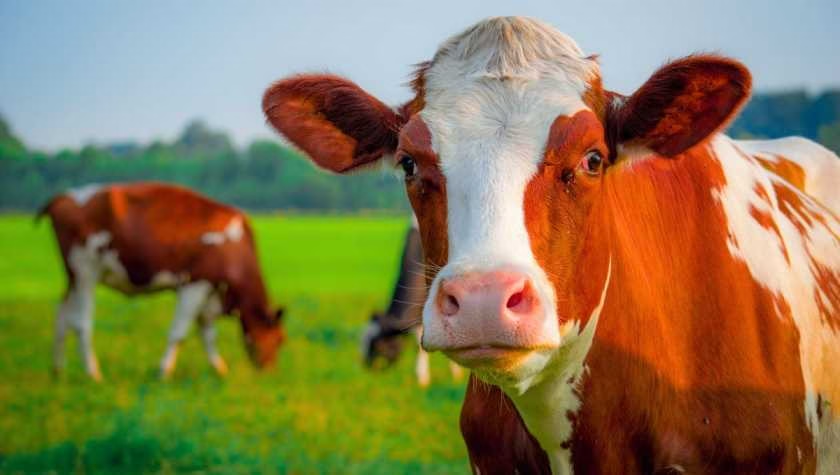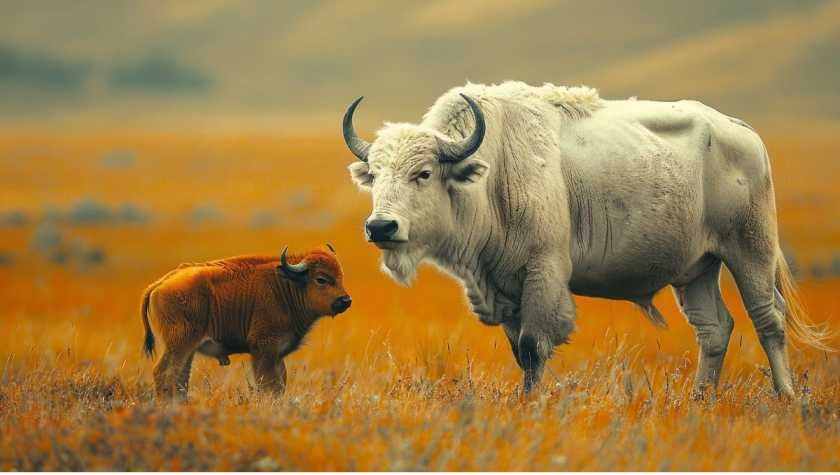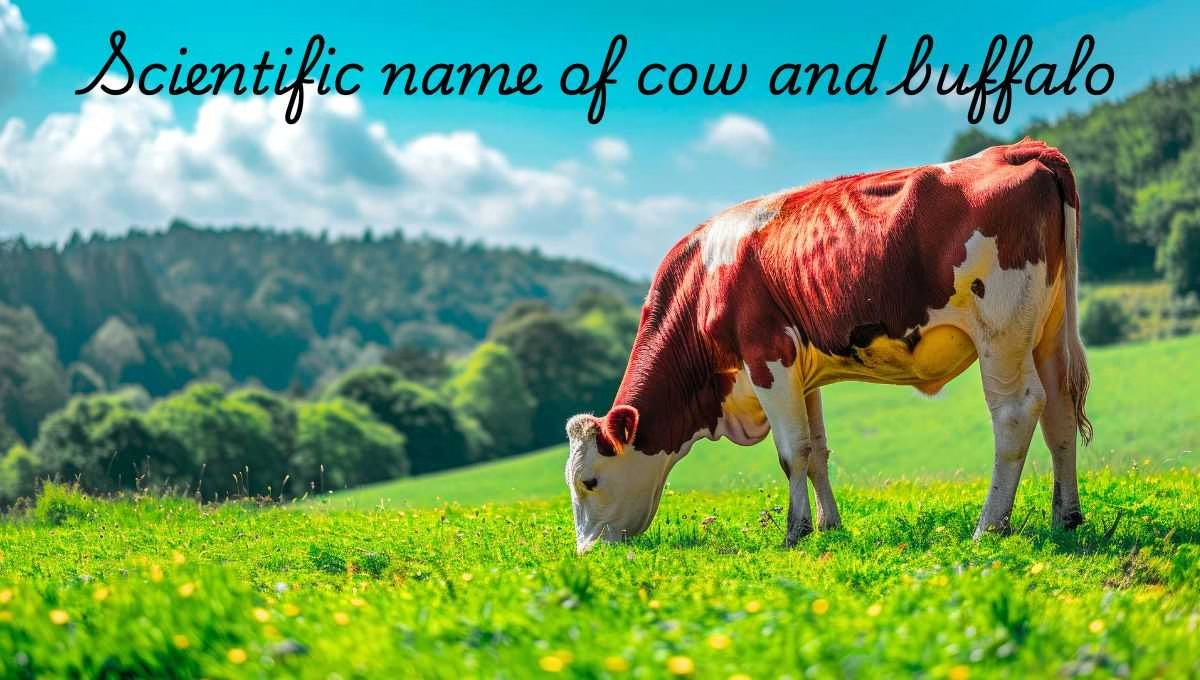Cow and buffalo: Since the dawn of civilization, cow and buffalo have been among the most valuable animals to mankind. They provide milk, meat, leather, and agricultural support, making them an integral part of rural and urban livelihoods. But have you ever wondered what their scientific names are or how they differ biologically?
In this article, we will examine the scientific classification, distinctive characteristics, and significance of both cows and buffalo. You will also learn interesting facts about how these gentle animals have been helping humans for centuries and continue to play a vital role in the agriculture and dairy industry today.
Let’s delve into the scientific identity of cows and buffaloes to understand why they are so important in our lives.
Scientific Name of Cow

The scientific name of the cow is Bos taurus.
It belongs to the family Bovidae under the genus Bos.
Scientific classification of cows:
- Kingdom: Animalia
- Phylum: Chordata
- Class: Mammalia
- Order: Artiodactyla
- Family: Bovidae
- Genus: Bos
- Species: Bos taurus
Interesting facts about cows:
Cows are domesticated herbivores and have been domesticated by humans for over 10,000 years.
Cows have a four-chambered stomach that helps them efficiently digest fibrous plant material through a process called rumination.
They are social animals, able to recognize faces and form strong emotional bonds with other cows.
An average cow produces 25-30 liters of milk per day, depending on the breed and diet.
Major cow breeds in India:
- Gir – Known for high milk production and disease resistance.
- Sahiwal – One of the best indigenous dairy breeds.
- Red Sindhi – Popular for its adaptation to hot climates.
- Tharparkar – A dual-purpose breed used for both milk and draught power.
Cows play a vital role in the agrarian economy, providing milk, manure, and draft labour – making them the “backbone of rural India”.
Scientific name of buffalo

The scientific name of buffalo is Bubalus bubalis.
It belongs to the family Bovidae, but under the genus Bubalus.
Scientific classification of buffalo:
- Kingdom: Animalia
- Phylum: Chordata
- Class: Mammalia
- Order: Artiodactyla
- Family: Bovidae
- Genus: Bubalus
- Species: Bubalus bubalis
Interesting facts about buffalo:
Domesticated water buffalo originated in Asia, and India has the largest population in the world.
They are excellent milk producers, with milk containing more fat and protein than cow’s milk.
Buffaloes are known for their strength and endurance, often used for farming and transportation in rural areas.
Buffalo milk contains about 7-8% fat, making it ideal for making ghee, cheese and butter.
Read more:- 10 Slowest Animals in the World That Will Leave You Amazed
Popular buffalo breeds in India:
- Mura (Haryana, Punjab): Known as the “black gold” of India for its high milk production.
- Jafrabadi (Gujarat): Heavy and strong breed, excellent as a dairy breed.
- Nili-Ravi (Punjab): Famous for its good temperament and milk production.
- Mehsana (Gujarat): A hybrid breed with balanced characteristics of Surti and Mura.
Buffaloes thrive in humid and humid regions and are more heat-tolerant than many cattle breeds, making them highly adaptable.
Difference Between Cow and Buffalo
| Feature | Cow (Bos taurus) | Buffalo (Bubalus bubalis) |
|---|---|---|
| Genus | Bos | Bubalus |
| Milk Fat Content | 3–4% | 7–8% |
| Color | Light brown, white, or black | Mostly black or dark gray |
| Horn Shape | Upward and curved | Longer, backward, crescent-shaped |
| Habitat Preference | Dry and grassy regions | Marshy and humid areas |
| Temperament | More social and docile | Slightly aggressive but hardworking |
Importance of Cows and Buffaloes in Human Life
Both cows and buffalo are not just animals; they are economic and cultural assets in many countries, especially in India.
1. Dairy production:
- Cows and buffalo provide nutritious milk, which is a major source of calcium, protein, and vitamins.
- Buffalo milk, being creamy, is ideal for dairy products such as cheese, butter, and yogurt.
2. Agricultural support:
- In rural areas, these animals are used for farming and transportation.
- Their dung acts as a natural fertilizer, improving soil fertility.
3. Cultural and religious value:
- In India, cows are considered sacred and symbolize purity and motherhood.
- Buffaloes are also valued during traditional festivals such as Pola and Makar Sankranti.
4. Economic value:
- Both contribute to the livelihood of millions of people through milk production, meat, hides, and by-products.
- India has emerged as the world’s largest milk producer, largely due to its robust cow and buffalo population.
Both cows (Bos taurus) and buffaloes (Bubalus bubalis) play an indispensable role in human life, from providing nutritious milk to agriculture and rural economies. Their scientific classification helps us understand their biological differences, but their importance in culture, economy, and ecology is universal.
To explore more insightful articles on nature, science, and animals, visit indnexa.com and stay informed!

Hi readers. I’m Piyali Batabyal, a passionate blogger who loves to share her thoughts, ideas, and experiences across a variety of topics—from lifestyle and beauty to personal growth and creativity. With a curious mind and a love for words.
Alongside my writing, I am also a professional makeup artist with a flair for enhancing natural beauty and creating transformative looks.

